So, you want to start dehydrating your own food.
(Of course you do, you’re awesome!)
Making your own dried fruit and raw foods is a delicious and cost-effective way of preserving your own grub – that’s why I’ve fallen in love with my Optimum P200 dehydrator (and thus, fallen in love with dehydrating all over again). A house full of dried nibblies is a very happy hours IMO!
I jumped at the chance to try and review the new Optimum P200 10-tray dehydrator when Froothie reached out recently. Having already owned a Optimum 9200 blender and Optimum 400 slow-juicer, so I knew the kind of quality I was up for, yet even I was surprised by just how amazing this machine is.
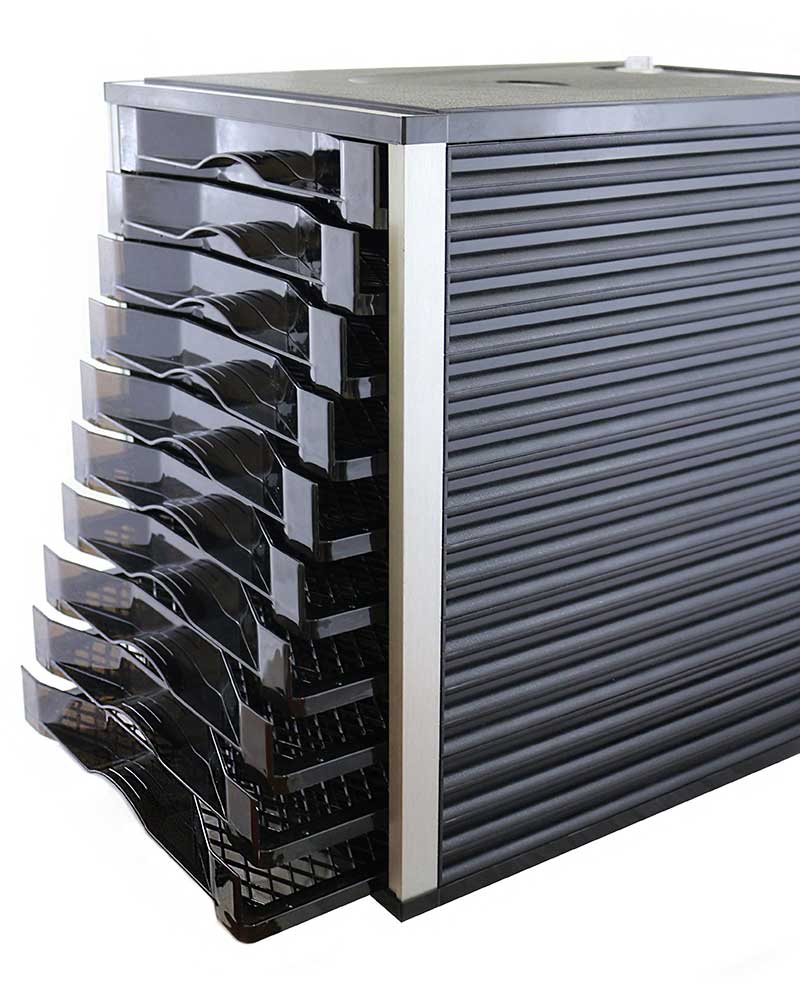
Optimum P200 Dehydrator First Impressions
There’s plenty of different options on the market in terms of dehydrators, ranging from the cheap-and-cheerful round tray dehydrators sold in department stores, to the popular-yet-expensive Excalibur models (which I also own). So what jumped out at me about the Optimum P200 versus these other units?
First, be prepared for the sheer size of the unit. At 50.5cm tall, this machine is a beast – making it a little tricky to find room for a permanent home for it. Currently I’m making do by sitting it on a disused side table in my garage. Not the most ideal spot and not the best for easy access currently, but a good compromise until I can shuffle stuff around. It’s also heavy, understandably for it’s size, so it’s not a machine I’ll be bringing in and out of the kitchen for use.
Thankfully, this huge size is also it’s best feature – creating lots of dehydrating tray room! I’m trialing the largest model of the two, which means I have ten whole trays of space for drying bulk amounts of goods. Each tray also has a large height – more information below on why that’s a huge plus.
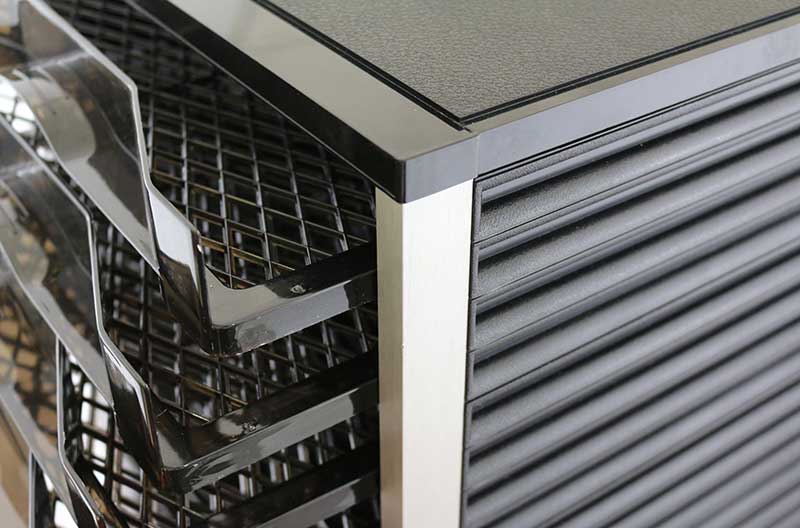
Ease of use
The control panel is well laid out and easy to read, with a LED timer display and handy temperature drying guide printed for quick reference. The temperature dial goes from a 29-68 degrees Celcius, incorporating temperatures suitable for raw food, food drying and jerky making. Also, the user manual contains all the basics of dehydrator operation, with temperature and timer suggestions for these popular food drying methods. This machine is practically foolproof in getting you from drying novice to dehydrating master!
My only concern on start-up was that the trays were a little hard to pull in and out, experiencing a bit of a ‘stuck’ feeling on the first few tries. With use however the drawers now move smoothly and fluidly – just needing a little workout out of the box to get moving properly.
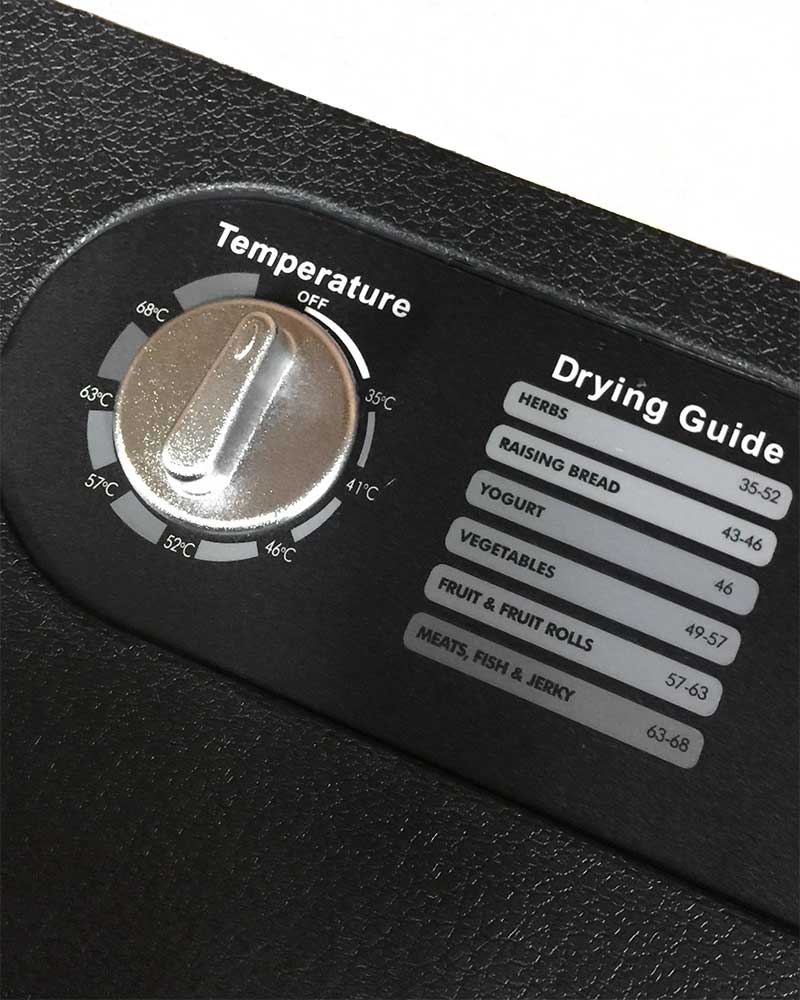
What I enjoy about the Optimum P200 Dehydrator
The dehydrating trays are large and widely spaced, to accommodate both a large amount of food on each tray as well as items of a larger height. This last aspect really appeals to me as I’m always having to remove or rearrange the trays from my previous dehydrator for different types of foods and products.
Having a 40 hour timer was also a great feature, as it gave me piece of mind to set-and-forget for foods I knew would take a long time to dry (Figs. Take. Forever). As an aside, everything seemed to dry slightly quickly and evenly as well, all thanks to the large fan in the back of the unit and the 800W motor.
The machine comes with both mesh and non-stick sheets (2x each) which can be used for different tasks. Foods that need lots of air circulation (like drying fresh produce) are best suited for the mesh sheets (or straight on the trays for larger items), while you would use the non-stick for raw food treats like fruit leathers, crackers and breads. While two of each is a good inclusion with the machine, I would suggest purchasing extras of the type you will use more based on your dehydrating needs – these are available on the Froothie website in convenient 5-packs (see photo below for visual of tray sheets – from top, normal tray design, mesh sheet, non-stick sheet).
I also had one niggly dislike – as on occasion I have used my Excalibur dehydrator to raise bread dough or culture yoghurt – two things I won’t be able to accomplish with this machine. Unlike the Excalibur, the Optimum p200 doesn’t have a front cover panel, meaning that you can’t remove any trays during the dehydrating process to make more room. The shape of the tray also prevents you from or swapping them forwards-backwards during the dehydrating process to increase an even drying process.
Neither of these concerns are a deal-breaker however, as I don’t actually need the machine for dough raising or culturing and all my resulting experiments were perfectly preserved using the recommended settings. If they are of conrern to you though, you might want to keep an eye out for the other Optimum dehydrator models being released soon that will have this feature due to a front cover inclusion.
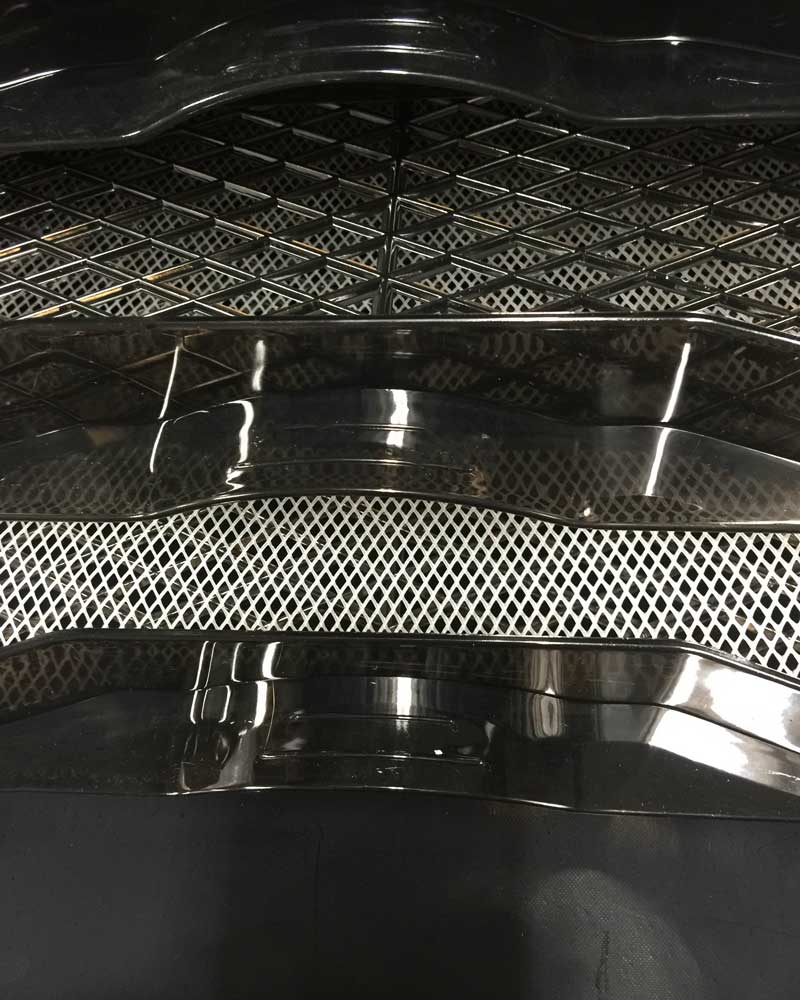
Who’s the Optimum P200 Dehydrator for?
- Raw foodies looking to make snacks, treats and other eats
- Home gardeners wanting to preserve the harvest
- Jerky connoisseurs who want know they could make it better homemade
- Health nuts and home cooks who to save money on expensive dried fruit and veg
I’ve spent doing bits and pieces of all of the above the past few weeks and I’ve got some raw snack recipes to show off on the blog soon too! If you want a headstart you could also check out any of the recipes I’ve previously made in my old machine too.
Availability and pricing
Froothie is the exclusive distributor of Optimum appliances, including the P200, slow juicers and blenders, with all products available on their website (including links to international regional sites).
For the size, motor and build quality, I feel like the $499 price tag ($399 reduced) for this Optimum P200 10-tray is a real steal. This price includes a 3-year warranty, as well as the mesh and non-stick tray inserts as discussed above.
If that’s out of your price range however, I would also recommend the 6-tray model for $399 ($299 reduced) based on my use of this machine. Both of these models are significantly more cost-effective than similar industry rivals – make sure to check out the Froothie product page for even more great product comparisons.
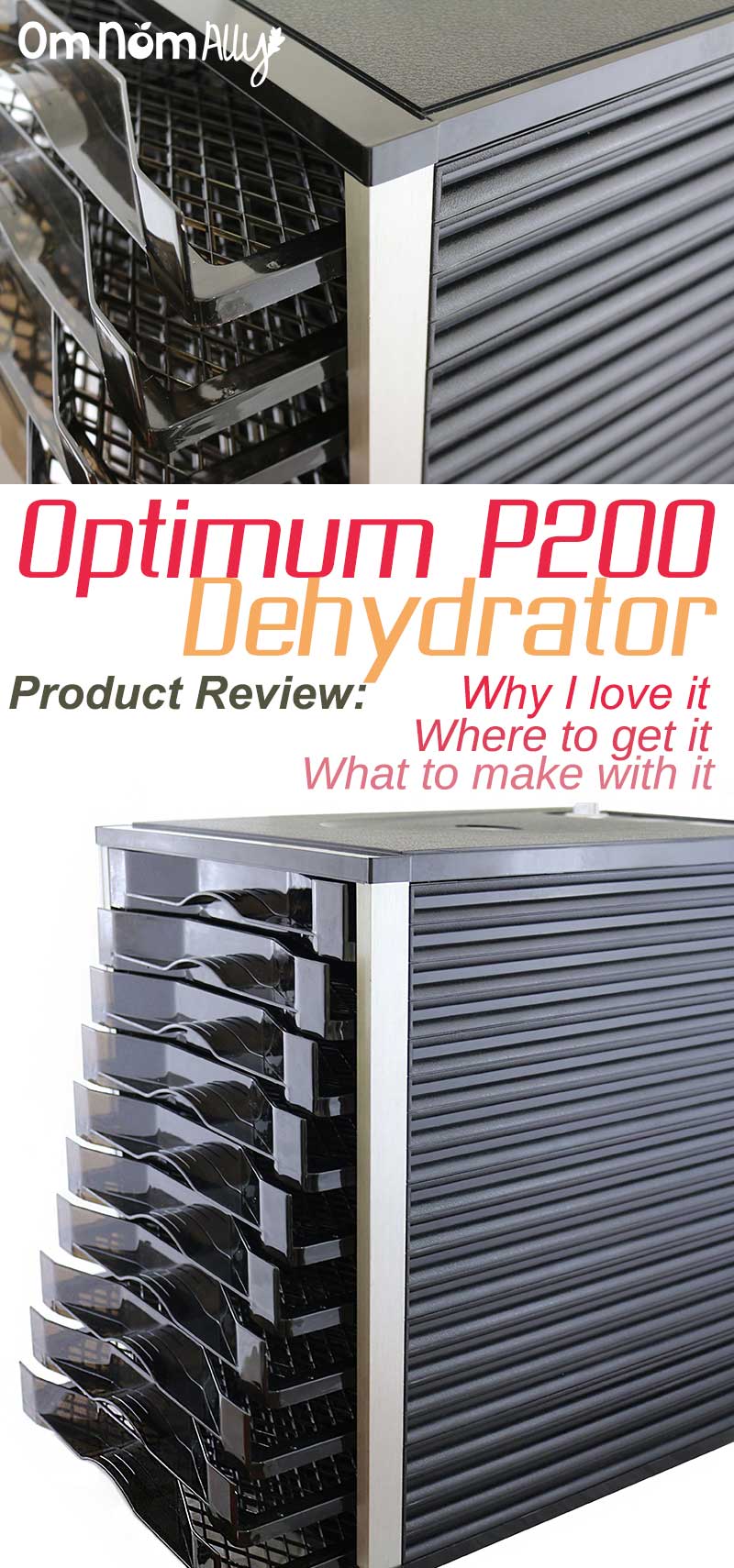
What did you think of the review? What do you want to know more about? What else should I make in the Optimum P200 dehydrator?
Leave me questions and comments below. In the meantime, I’ll be off experimenting with my new favourite appliance!

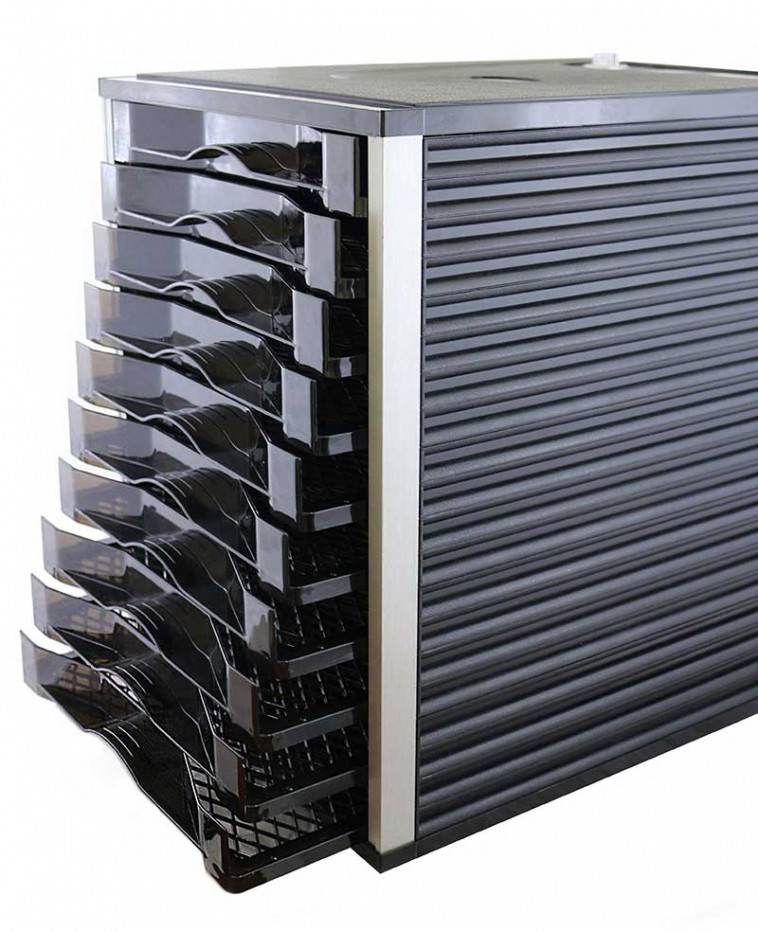
Comments 17
Great review, lovely to see a real review on it. Now I think I want to wait to buy mine as I’d love to be able to take trays out for high stuff to fit in x
Author
Thanks for the comment Mikayla 😀 I agree about wanting to remove the trays, I’m very glad they are bringing out a model that will accommodate this feature for people that want the option too 🙂
That looks like quite the dehydrator! I don’t have one but I’ve heard dehydrating tomato slices with oregano sprinkled on top tastes just like pizza. 🙂
Author
I’m really impressed with the build quality and functionality of the Optimum Amy 🙂 You know what, it tastes almost EXACTLY the same as pizza. I’ve actually got a ‘sun-dried’ cherry tomato instructional coming out soon that I think you would love!
thanks for posting this review. I’ve been wanting to purchase a dehydrator for quite a bit of time now, very helpful!
Author
Thanks for the comment Bridget, glad you found the review helpful!
Great review Ally thank you 🙂 I’m wondering if you have noticed much of an increase in your power bill when using your dehydrators? I like the idea of activating nuts and seeds and not always do I want to use them wet so I’m thinking of soaking and then drying in quantity. Would probably go for the 6 drawer though just because of bench space. I’m also curious if the dehydrator would still work with a drawer out for higher cakes or yogurt…maybe just taking a little longer? Or maybe just a piece of cardboard covered with foil to act as a front would be enough….any thoughts on this? The tomatoes with oregano “pizza” alone sound an enticing enough reason to get one lol!
Author
I’ve owned an Excalibur dehydrator for a long time as well and have honestly never noticed a drastic change in the power bill. I have however read in some manufacturer’s documentation that a dehydrator runs at about 2-3c an hour (vs say a clothes dryer at about 50-60c an hour, so it’s not incredibly expensive to run for a 6-12 drying time 🙂 Great question Katelyn, thanks for the comment 🙂
Thanks Ally, thats encouraging. 🙂 Do you have a view on the second part of my question about the Optimum 200…or I suppose you haven’t had the need to experiment with this since you’ve also got the Excalibur…just wondered if this could work….
Author
My apologies Katelyn! I did mean to answer that part too and after pondering for a while I forgot to write it down!
You would definitely have to cover the front of the unit with something, as leaving the front off would cause all the warming air to disappear and the food inside the machine would not dry correctly.
It’s not all about the temperature set on the dehydrator you see, but also the circulation of that air to slowly dry the food out. A large piece of foil over the front of the unit could be a quick fix possibly, I’m having some bread baking adventures over the next few weeks so I will experiment and report back 🙂
Thanks so much Ally! I’ll look forward to your results. But I’d hate to see you ruin your bread in the experiment if it doesn’t work..so only if you are keen yourself to try it… 🙂
Author
Wouldn’t be ruined, only take a bit longer to rise I would imagine 🙂
Hi Allison…just read your review, thanks for that. I’m in the proces of gathering info to help me make the best choice as possible for a dehydrator. I want to dry my produce out of my garden…prunes, apples, pears, strawberries, tomatoes, sweet potatoes etc..
Read the trays can’t be swapped..did you find it neccesary to do that? or does it works fine as it is..
btw wonder if you came about the bread experiment (taking trays out and covering it with some cardboard etc)
Author
Sorry for the late reply! The bread experiment wasn’t great, it’s very hard to adequately cover the dehydrator if you remove trays (as it’s such a large unit). To open up and check the dough or etc and cover back up is a bit of an exercise.
I use the unit a lot of general dehydrating (including a lot of ingredients you’ve mentioned in your comment). But for now dough raising, or any tasks that require removing the trays is a no go. Mind you, 95% of the time I wouldn’t need to remove any trays anyway as they are quite roomy, and tall! I hope that info helps 🙂
Hi Ally,
I’ve only just seen your review and its been very useful, but I’m hoping you can offer some additional advice. I’m looking to dehydrate a high quantity of food, and I mean a whole lot, to vacuum pack and store to take on a year long trek I’m planning (better nutritional value in home made than store bought).I know the P200 or Excalibar will do all my snacks and jerky etc, but I’m trying to find out;
– would they stand up to use every second day and possibly upon occasion every day
– do they dehydrate purees/sauces and meals – like stew or spaghetti
This is all new to me, so I am going out on a limb with it and don’t want to throw my money away. I can dehydrate meals with the oven, but it isn’t as efficient and they don’t keep as long as I need them to.
Thanks for any help or advice you might have.
Author
Hi Ro, thanks for the comment and excellent questions!
A dehydrator is the perfect tool for the sort of recipe bases and snacks you want to make and the machine is an absolute workhorse that would be capable of use ongoing everyday. I run it at least twice a week for drying jobs and have never had any issues so far, so I’m confident in it’s capabilities in this regard.
Further, for use to dehydrate meals and sauces, the best way to achieve this is to spread the prepared mixture out as thinly as possible onto a lined baking tray or lined dehydrator trays so the surface area is increased. This will allow for a much faster dehydration of the liquid contents and allow for longer preservation. While an oven on a low temperature is a good option, it is in fact still ‘cooking the food’ and will not dehydrate in the same manner, leading to a higher likelihood of food spoilage.
For a more in-depth answer I would look into the two following books: Trail Food: Drying and Cooking Food For Backpacking and Paddling, as well as my favourite dehydrating book http://amzn.to/2bH50IY.
Hey Alison, thank you for this article.
Food dehydrators are a blessing.
If you are able to dry your food properly, all the taste will remain in the food. This is why it is important to have a procedure before you start and follow it religiously.
You may think that if you start dehydrating food, you will lose the taste. What really happens is that the taste becomes more concentrated. Consequently, when you dehydrate food, you are removing the water and preserving the flavor.